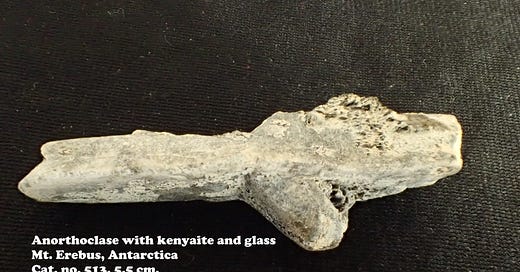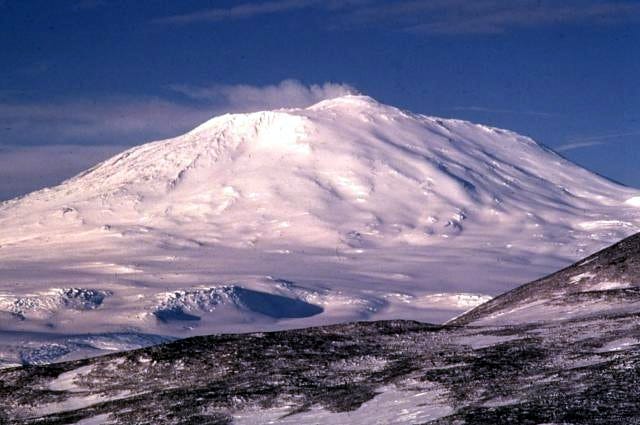This is my only specimen from Antarctica. It’s anorthoclase, a sodium-rich potassium feldspar, (Na,K)AlSi3O8, with a partial coating of kenyaite, a hydrous sodium silicate, Na2Si22O41(OH)8 · 6H2O. It comes from the active volcano Mt. Erebus where an unusual lava lake has existed for at least 50 years. The lava is compositionally phonolite (equivalent to nepheline syenite), which is an alkali-rich, low-silica fine grained rock. It’s the same rock type that constitutes Devil’s Tower in Wyoming.
These rocks are unusual and seem to be related to mantle hot spots that send magma up through relatively thick continental crust. Mt. Erebus is in the West Antarctic Rift System, a long fault zone similar to the East Africa Rift System, and indeed, large anorthoclase crystals like this and the alteration to kenyaite (named, of course, for Kenya) are only common in those two settings. Apparently the crystals which must have grown slowly down inside a magma chamber are erupted inside of volcanic bombs, from which they weather out. Some bits of glass (obsidian) cling to the anorthoclase crystals, mostly only visible under magnification.
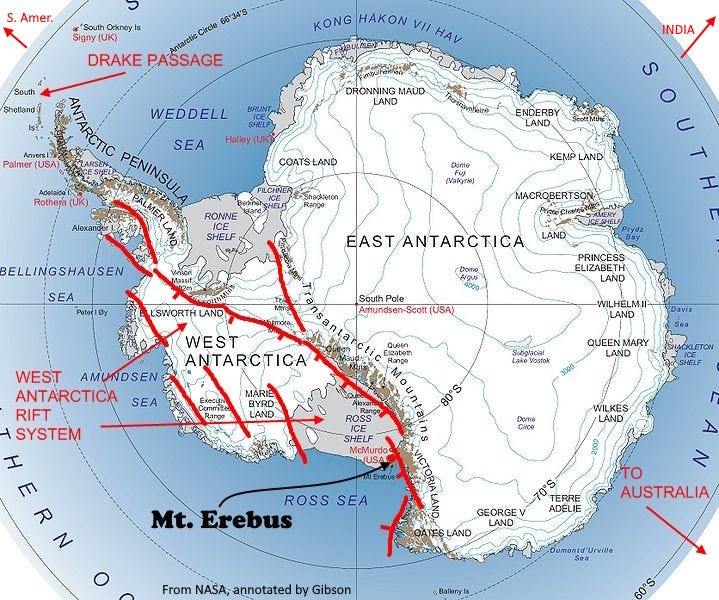
Although Antarctica is essentially one single (semi-)stable tectonic plate today, the rift within it that separates West and East Antarctica is clearly active, as indicated by the vulcanism.
Anorthoclase is from Greek words meaning “not right break” for its cleavage which is not at 90 degrees. With nomenclature changes, it’s now considered to be a potassium-rich variety of albite, sodium plagioclase. Not to be confused with anorthosite, a rock common on the moon that is dominated by calcic plagioclase (usually labradorite, also no longer technically a discrete mineral, but a variety of anorthite (not to be confused with, either), the calcium end member of the albite-anorthite plagioclase feldspar series). Yeah, I don’t really like these confusing names, but then I’m old.
Anorthoclase crystallizes at temperatures above 400°C, relatively high. Its crystals are usually triclinic, the least symmetrical of the crystal systems, meaning its three crystal axes are of unequal lengths and are all at unequal angles to each other (and none at right angles). But because it is an intermediate composition between triclinic albite, Na(AlSi3O8), and monoclinic sanidine, K(AlSi3O8), stuff called “anorthoclase” can be either triclinic or monoclinic. You have to do chemical and x-ray analysis to be sure, but anorthoclase from Mt. Erebus has been analyzed as on the albite side of the mix - Ab65An16Or19, where Ab65 means 65% albite (the sodium end-member), An is 16% anorthite (calcium), and Or is 19% orthoclase or sanidine, the potassium end (Kyle, 1977, Mineralogy and glass chemistry of recent volcanic ejecta from Mt Erebus, Ross Island, Antarctica: New Zealand Journal of Geology and Geophysics, 20:6, 1123-1146).
Since a mining treaty went into effect in 1998, you can’t remove minerals from Antarctica except for research, but this was collected before that by a researcher there, who gave it to a friend of mine, who gave it to me – so it’s legal for me to have it! #513, 5.5 cm.
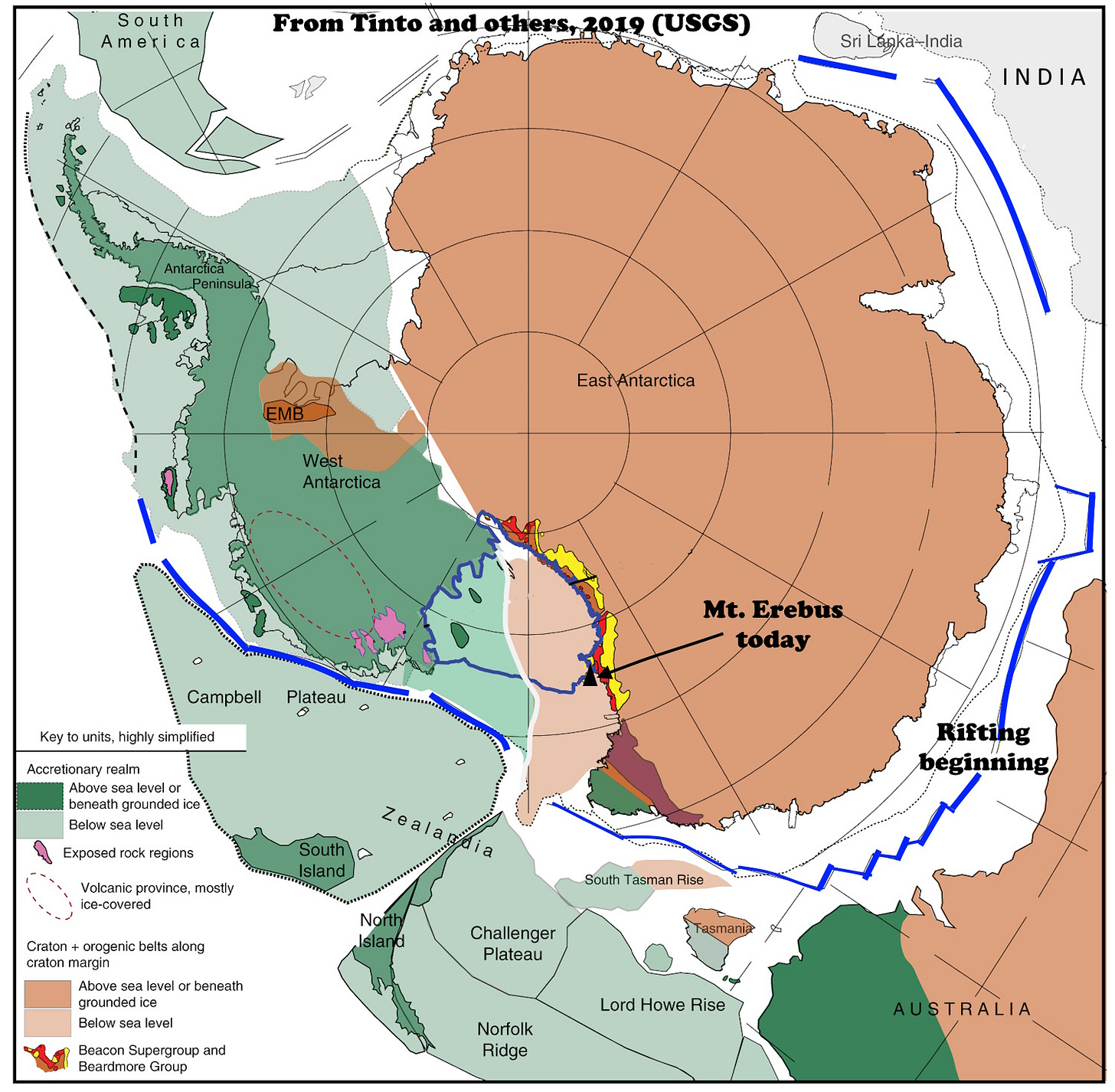
Australia and Antarctica began to rift away from each other back in the Cretaceous, probably about 95 million years ago, with the initial faulting and rifting beginning in the Jurassic. The separation was pretty slow for many millions of years, so that by Eocene time (45-50 million years ago) the distance between Antarctica and Australia was only about 500 km, or 300 miles, with something rather like the modern Red Sea between them. The speed of separation and amount of sea-floor spreading increased in Eocene time from maybe 4 cm per year to 7 cm, and today there’s an ocean basin 3400 km (2100 miles) wide between them, and it’s still growing, still at about 7 cm per year.
Within Antarctica, all was not quiet. The West Antarctica Rift was the beginning of a pull-apart between the larger East Antarctic craton and the smaller West Antarctica area. It started probably during the Cretaceous and continues sporadically to this day. The flank of the rift is more or less the Trans-Antarctic Mountains today, and the active volcanism there including Mt. Erebus is probably related to ongoing activity along the rift. A recent study (Hill and others, 2022, Trans-crustal structural control of CO2-rich extensional magmatic systems revealed at Mount Erebus Antarctica: Nature Communications 13, 2989) suggests that the vulcanism has a mantle source near 100 km below the surface, for the heat and possibly for the magma itself.
Climate change together with the uplift of the mountains in central Antarctica led to the development of snow cover there beginning about 34 million years ago. The boundary between the Eocene and Oligocene, 34 million years ago, is marked by a decrease in carbon dioxide levels and general global cooling, which allowed for the beginning of ice buildup in Antarctica. Before about 34 million years ago, there was no ice in Antarctica even though it was near the south pole.
The last connection between Antarctica and any other continent, South America, also disappeared about 35 to 40 million years ago. With the opening of the Drake Passage between Antarctica and South America, the circumpolar ocean current was established, and its presence prevented significant interchange of tropical and polar waters. This was another factor in the cooling of Antarctica.
The West Antarctic Rift is positioned about where Australia and New Zealand were attached to Antarctica in the old Gondwana. The Tasman Sea, between Australia and New Zealand, began to extend and separate those areas back in the Cretaceous, about the same time as the West Antarctic Rift began. Even though it’s been active for close to 100 million years, the West Antarctic Rift hasn’t really gone anywhere. The active volcanism shows that there is still extension of the crust, breaking, to let the magma up, but an ocean has not formed between West and East Antarctica. The Tasman Sea spread for about 22 million years, 80 to 58 million years ago, Cretaceous into the Paleocene epoch of the Cenozoic, and then apparently stopped. Today, Australia, the Tasman Sea, and about half of New Zealand – the part west of the Alpine Fault – are together on the same tectonic plate. The whole package is pushing against the Pacific Ocean Plate, making for some complex, violent interactions along oceanic trenches north of New Zealand and in collision zones in New Guinea. The oceanic part of the Australian Plate northwest of Australia itself is subducting beneath the southern part of Asia, in Indonesia.
So – the bottom line for Antarctica is that two things – tectonics and the positions of continents, together with climate change and general cooling – led to the beginning of the modern Antarctic ice sheet about 34 million years ago, about at the boundary between the Eocene and Oligocene epochs of the Cenozoic. It’s had a long time to build up its ice – much longer than the ice ages at lower latitudes that happened in the past 2 million years or so.
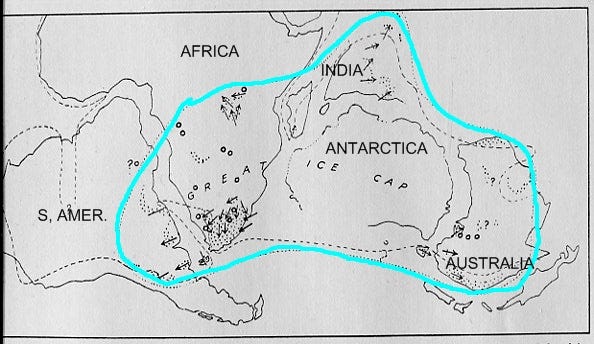
The freezing of Antarctica 34 million years ago was the second time relatively recently that the continent had been largely covered with ice. When they were integral parts of Gondwana during Carboniferous to Permian time, about 340 to 270 million years ago, Antarctica and adjacent South America, Africa, India, and Australia were all partly glaciated at a time when the South Pole was probably in what is now South Africa. That variable glacial episode lasted tens of millions of years.
Mt. Erebus was named in 1841 by British explorer James Clark Ross for his ship, the H.M.S. Erebus, which was named for the Greek god that personified primeval darkness. Ross also named the nearby extinct volcano Terror for his other ship. The ships Erebus and Terror also carried the lost Franklin expedition to the Canadian Arctic where they became icebound in 1847. The sunken Erebus was found in 2014 and the wreck of Terror was discovered in 2016. Terror had previously seen action at the War of 1812 Battle of Baltimore and Fort McHenry, where the Star-Spangled Banner was written, but Erebus was not built until 1826.

